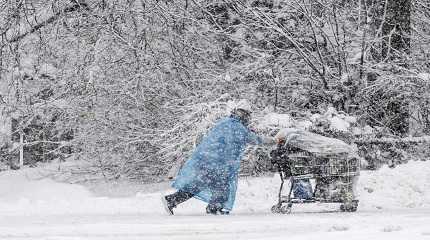
ANCHORAGE, Alaska (AP) — Four homeless people have died in Anchorage in the last week, underscoring the city’s ongoing struggle to house a large homeless population at the same time winter weather has returned, with more than 2 feet (61 centimeters) of snow falling within 48 hours.
The four bring the total number of people who died while living outdoors in Anchorage to 49 year this year, a record that easily eclipses the 24 people who died on the streets of the state’s largest city last year, according to a count kept by the Anchorage Daily News.
Eleven of those deaths last year came during winter months.
This week’s heavy snow covered tents and vehicles that homeless people set up in makeshift camps all over Anchorage when the city closed the mass shelter that was established inside the city’s sports arena during the pandemic.
While the city cleared at least one of those large camps, some people have decided to rough it outside this winter instead of seeking shelter.
Of the four recent deaths, a sleeping woman died Thursday after her makeshift shelter caught on fire, possibly caused by some type of heating source used to warm it.
The three other deaths were all men. One was found dead in the doorway of a downtown gift store where he often slept. Another died alongside a busy road near a Walmart, and the third in a tent at an encampment near the city’s main library.
Since there were shelter beds available when each person died, other factors may have been at play, including lack of transportation or access to health care, confusion on how to get a shelter bed or onto a wait list, or refusal to go to a shelter, the Anchorage Coalition to End Homelessness said in a statement.
“Ensuring that unsheltered people have access to health care providers, Narcan, fentanyl test strips, harm reduction counseling, and behavioral health treatment are the effective interventions needed to reduce outdoor deaths,” the statement said.
“It makes you wonder what could we have done better to prevent that from happening,” Felix Rivera, an Anchorage Assembly member who chairs the Housing and Homeless Committee, said of the four deaths.
The city has pieced together a short-term fix with added temporary shelter beds, but the only way to prevent more deaths is by building more housing, he said.
“We’re going to do what we need to do to make sure that folks aren’t dying outside, but if we’re not focusing on the permanent solution, then a Band-Aid is going to be worse,” he said. “We’re going to run out of funds at some point to be able to continue doing these kind of things.”
Anchorage has struggled to find a solution to house the homeless after the arena closed.
The city’s conservative mayor and liberal assembly couldn’t agree on a new mass shelter, leaving Mayor Dave Bronson to suggest the city give out one-way airplane tickets to the homeless to leave the city — an idea that was widely criticized in and outside Alaska.
That plan was never funded, leaving the city scrambling to find shelter at old hotels and apartment buildings. Late last month, Anchorage opened a new 150-bed mass shelter at the city’s old waste transfer station administration building.
Alexis Johnson, the city’s homeless director, told The Associated Press at the time the patchwork solution should provide enough beds for the city’s 3,100 or so vulnerable population.
There were 28 beds open at one facility on Friday, but those would likely be taken before the weekend was out, Rivera said.
The Bronson administration will present plans at an Assembly meeting next week to add 50 beds to that facility, which Rivera called a welcome move. He also anticipates the administration possibly presenting plans for warming centers and an additional shelter, if necessary.
City buses didn’t run Thursday or Friday because of the heavy snow, taking away an easy warming place for the homeless, Rivera said. It also prevented many low-income people from being able to travel to shelters or other social service programs.
During this week’s storm, the temperatures haven’t been bone-chilling, hovering around the 30-degree F (-1-degree C) mark, but that will soon change. The forecast calls for single-digit temperatures next weekend.
This week’s storm dropped 17.2 inches (43 centimeters) of snow at the city’s official recording station, the National Weather Service office near the airport and coastline. However, other parts of Anchorage, especially those closer to the Chugach Mountains on the other side of town, recorded up to 30 inches (76 centimeters).
The snowfall broke two daily records. The 9 inches (22.86 centimeters) on Wednesday broke the record of 7.3 inches (18.54 centimeters) set in 1982, and the 8.2 inches (20.83 centimeters) that fell Thursday broke the record of 7.1 inches (18.03 centimeters), set in 1956, said National Weather Service meteorologist Nicole Sprinkles.
The community of Girdwood, located about 35 miles (56 kilometers) south of Anchorage and home to a ski resort, topped out at 3 feet (0.91 meters).
The Anchorage total was on top of about 6 inches (15 centimeters) that fell Sunday.
The storm caused widespread power outages, forced schools to either cancel classes or switch to remote learning and prompted some highway closures.




